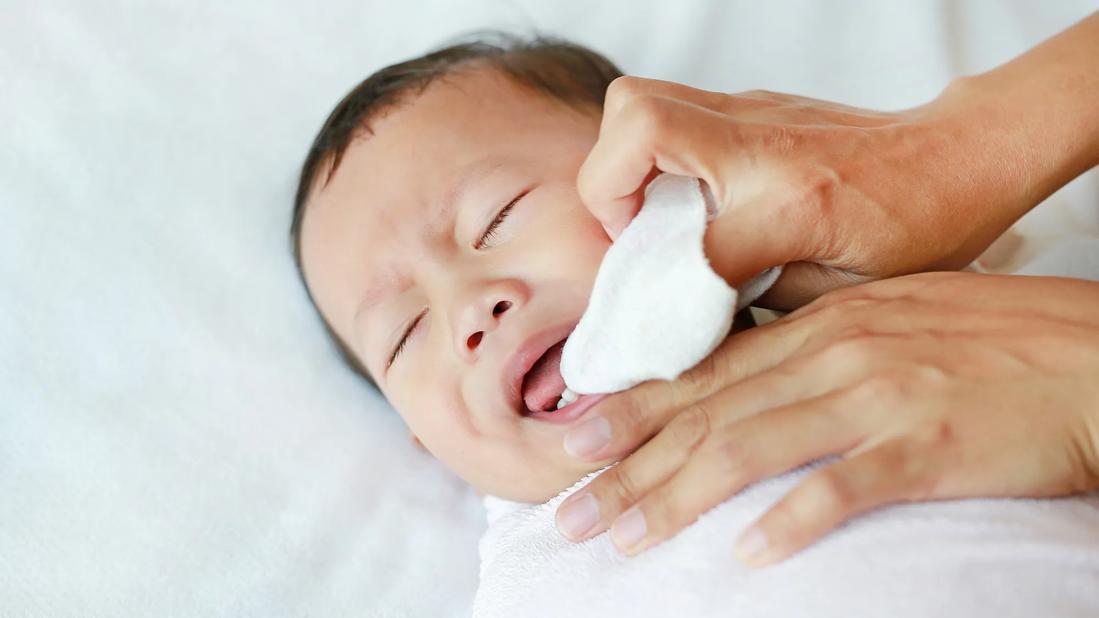Clean your baby’s mouth with a washcloth or small toothbrush if they have a tooth or you suspect thrush

If there’s one thing new parents know, it’s that babies don’t come with instruction manuals. So, every question you have about keeping this itty-bitty person safe and healthy is likely to send you down a rabbit hole searching for information. Opinions vary, and so do the qualifications of the people providing them.
Advertisement
Cleveland Clinic is a non-profit academic medical center. Advertising on our site helps support our mission. We do not endorse non-Cleveland Clinic products or services. Policy
Sound familiar?
Advice about cleaning your baby’s tongue is one of those topics. What do the experts have to say about it? We asked pediatrician Shannon Thompson, DO.
You don’t need to regularly clean or wipe your baby’s tongue in their first few months, unless:
Otherwise, consider cleaning your baby’s tongue one of those things you don’t have to do.
“As long as you’re being very gentle, there’s no risk in cleaning your baby’s tongue once a day if that’s something you want to do. But it’s not something we typically recommend because, until they have a tooth, it’s just not necessary,” Dr. Thompson clarifies.
Some people will tell you that cleaning your baby’s tongue or gums prevents thrush, but that’s not true. Thrush is a common infection in babies. But a milky tongue isn’t the cause. Thrush is an overgrowth of Candida fungus. Babies pick it up when nursing or drinking from a bottle. And cleaning your baby’s tongue after feedings or at the end of the day isn’t going to prevent it.
Advertisement
If your baby is teething or you’re concerned they may have thrush, follow these steps to clean their mouth:
If checking for thrush is your goal, look to see if the milky residue wipes away. If their tongue is clean, all is well. “If it’s thrush, you’ll still see white lesions or residue after you clean the baby’s tongue,” Dr. Thompson says. “Thrush doesn’t wipe away.”
Thrush is typically treated with prescription antifungal medications. Call a children’s healthcare provider, like your pediatrician, if you suspect your baby has thrush.
Until babies are teething, their mouths don’t need your intervention.
And chances are, they're not going to love you sticking your fingers in their mouth. (Can you blame them?)
And despite what you may hear, regular tongue-cleaning isn’t likely to make a difference in them “getting used to it.” Cleaning a newborn’s tongue isn’t going to make the transition to toothbrushing any smoother.
“It’s important for babies to get used to toothbrushes because it’s important for oral hygiene moving forward,” Dr. Thompson acknowledges. “But cleaning their tongue and mouth in the first few months of their lives, before they have teeth, isn’t going to help them develop a tolerance for it.”
Advertisement
Learn more about our editorial process.
Advertisement

Adding extra formula, cereal or medications to your baby’s bottle is a dangerous and misguided practice

Teaching your baby to sign may help ease frustrations before they can talk, but it’s not a must-do

Babies can get congested easily, but you can calm their cough by keeping them hydrated, using nasal drops and running a humidifier

Try to burp your baby mid-feed and after they finish eating — but don’t sweat it if they don’t burp

Most babies will recognize their name by about 9 months old

‘Social smiles’ typically start around 8 weeks old, while laughter comes later — around 4 to 6 months

Most infants can roll from tummy to back by 6 months old — but remember, every child develops at their own pace

Too much time in certain infant ‘containers’ can cause developmental delays and a flat spot on baby’s head

Start having sex about 72 hours before ovulation, then at least every other day during your fertile window

Attachment theory suggests that your earliest relationships shape connections throughout your life

It isn’t a recognized mental health disorder, but research shows that problematic social media use can negatively affect your mental health, self-esteem and sleep